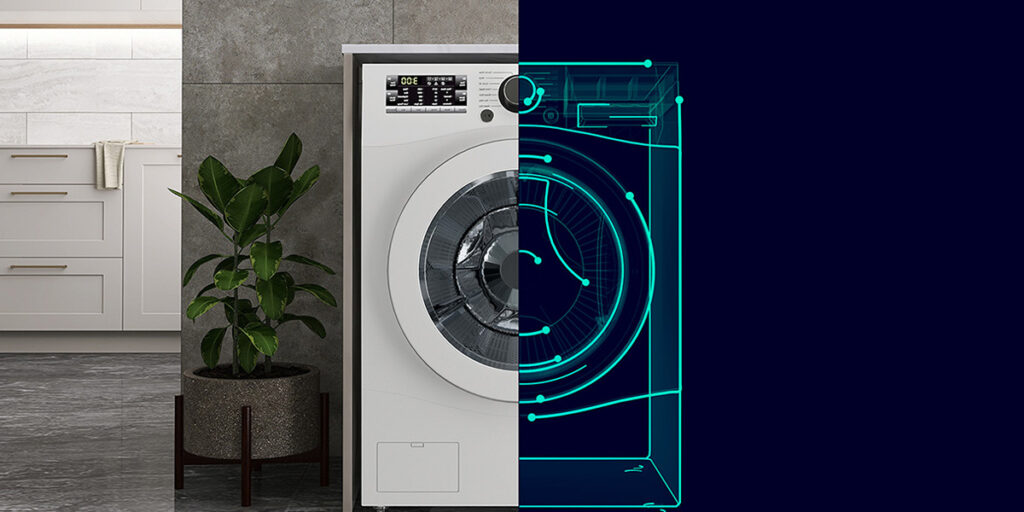How to future-proof your consumer goods with sustainable innovation

In today’s dynamic market, Digital Twin technology is emerging as a key driver of consumer goods innovation, enabling levels of agility and insight that were previously unattainable. The landscape of today’s consumer goods industry is rapidly evolving, demonstrating that the only constant in our world is change. It is the defining feature of our time. Brands, once the epitome of consistency, are now being forced to adapt at a rate that would have been unthinkable a decade ago. This new reality presents opportunities and challenges as rapid market shifts and volatile consumer preferences require a paradigm shift in agility and foresight.
At Siemens, we recognize that as the landscape shifts, traditional product development strategies become too slow, rigid and linear. Companies must be vigilant and innovative, pivoting before each disruption.
In this context, brands must not only create what consumers want but also quickly innovate to meet their demands without compromising quality or sustainability. Market trends that used to take years to evolve can now emerge and vanish in a matter of months or even weeks. The digital age has brought democratization of influence, with a single social media post sparking a global trend, making consumer loyalty dependent on a brand’s ability to stay relevant. Consumers – especially influencers – have the power to rapidly boost or decrease demand for a product via the internet instantaneously.
The imperative of responsiveness in consumer goods manufacturing
Today’s consumer goods companies face a paradox: the need for rapid innovation in the face of increasing product complexity, as well as consumer wants for personalization and sustainability. In this setting, Siemens is the strategic partner for agility. Our NX and Teamcenter platforms are critical in the shift from slow, linear development to dynamic, interconnected processes that span traditional silos.
Brands are under immense pressure to reduce their product development cycles. In this high-stakes environment, being first to market can sometimes mean being best in market. However, with the vast majority of new products failing to meet their launch goals, it’s clear that speed alone isn’t enough—it must be combined with strategic validation and awareness of market preferences.
Digital twin technology: The vanguard of validation
Siemens’ digital twin technology acts as a transformative bridge to manufacturing, shifting the focus from a single product to a holistic perspective of the entire creation process. This is a realm in which every part of the product, from the initial design to the final packaging, can be validated in a virtual world that simulates real-life conditions, effectively blurring the lines between virtual and physical. This innovative approach allows companies to:

- Test and adapt products in a risk-free simulated environment
- Significantly reduce the costs and time involved with physical prototyping
- Ensure that the final product is market-ready and tailored to consumer preferences and sustainable practices.
For example, the success story of ARGOLF illustrates the practical applications of Siemens technologies. As a golf club manufacturer, ARGOLF has used Siemens NX and Teamcenter to digitalize their production processes successfully, significantly reducing reprogramming times for design changes and improving their ability to respond quickly to consumer feedback and market trends. These capabilities are crucial in industries that rely on customization and speed to maintain a competitive advantage.
We particularly appreciate the highly visual machining simulation features in NX that are a great help in our daily work because we can digitally validate and optimize the machining process. NX CAM offers an integrated postprocessing system that directly generates the machine’s ISO code without having to use a third-party postprocessor; this is an important advantage.
Cédric Gautier, Head of Research and Development, ARGOLF
Sustainability and AI: Forging an intelligent path forward
Artificial intelligence (AI) stands as a pillar in the pursuit of sustainability. AI enables brands to design and manufacture with a focus on sustainability by using predictive analytics and intelligent automation. This proactive approach embeds sustainable innovation into the product lifecycle from the start.

Siemens employs AI to help companies optimize their design for sustainability, ensuring that each product is as environmentally friendly as it is innovative. AI gives insights that enable smarter resource use, increased energy efficiency, and reduced waste, aligning the product’s journey with the shifting sustainable values of society.
Innovation: More than a buzzword
The concept of innovation in the consumer goods industry has evolved. It’s no longer only about coming up with new ideas but also about how quickly these ideas are brought to market. Consumer trends that used to take years to develop now shift in a matter of days. In this volatile industry, brands struggle to keep pace, often challenged by slow, disconnected development processes that fall behind the market’s pace. With most products failing to launch, the need for a more responsive, integrated approach has never been greater.
A recent study by McKinsey highlights the harsh reality facing consumer goods companies: the average first-year sales for new product leaders declined by an astonishing 50 percent between 2012 and 2018. This stark decline underscores the importance for companies to refine their innovation strategies to better align with rapidly changing consumer demands and market conditions.
This is where Siemens NX and Teamcenter shine—they allow brands to collaboratively iterate rapidly and with precision. They revolutionize not just the product design but the entire process behind it. Digital Twin technology is pivotal in this approach, providing a virtual prototype that allows brands to simulate, validate, and optimize products and processes before entering the manufacturing stage. This feature significantly enhances sustainability by minimizing the need for physical prototypes, resulting in less waste and resource usage.
Addressing today’s struggles with tomorrow’s technology
In tackling the pain points of today’s brands—how long it takes for products to go to market and the alarming rate of new product failures—Siemens delivers more than just a promise; we provide proven solutions. Consumer brand organizations can use NX and Teamcenter to gain quick access to innovative solutions that shorten the process from concept to consumer.
Brands can tap into a suite of solutions that allow them to:
- Synchronize design and manufacturing to reduce go-to-market time
- Embrace a culture of constant innovation in which products are developed, tested, and refined in response to evolving market data and consumer feedback
- Implement virtual validation processes to ensure that products are not just quickly developed but thoroughly validated and market-ready
Siemens is ready to power your brand innovations with NX and Teamcenter, the catalysts for a revolution in responsiveness, innovation, and sustainability. With these fully integrated solutions, you can confidently navigate market fluctuations, knowing that your products will appeal to consumers today and meet the demands of tomorrow. Together, let’s embrace this digital transformation and redefine what it means to lead in the consumer goods industry.
Ready to experience the power of NX cloud-connected products?


